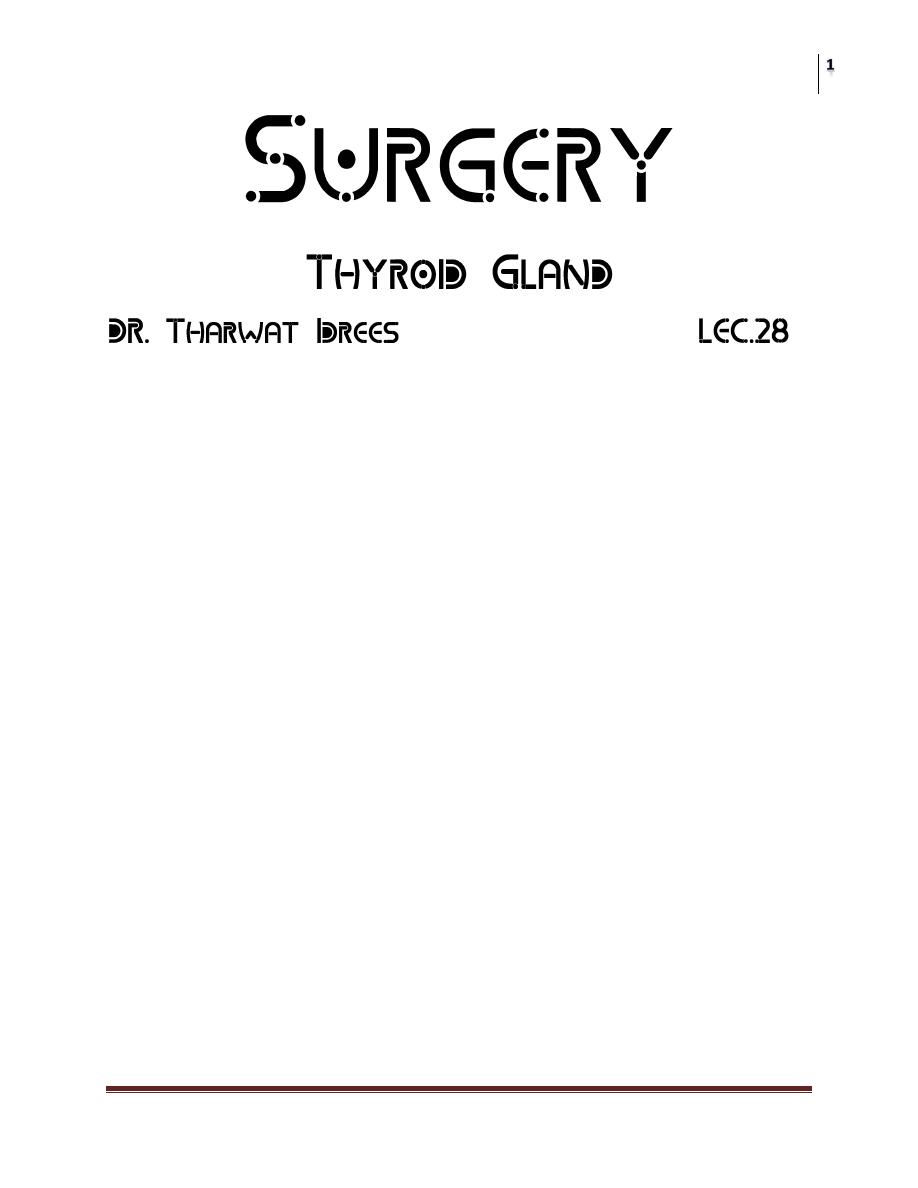
Surgery
Thyroid Gland
Dr. Tharwat Idrees
Lec. 28
Located in the central part of the neck. 2 lobes on both sides of trachea and central
isthmus
Weight: 20 to 25 gm.
Blood supply:
1. Superior thyroid artery – a branch from external carotid artery
2. Inferior thyroid artery – from the subclavian artery.
Venous drainage:
1. Superior thyroid vein---- to jugular vein.
2. Middle thyroid vein--- to jugular vein.
3. Inferior thyroid vein --- to brachiocephalic vein.
Lingual thyroid
Lateral abbarent thyroid
Median ectopic thyroid (tongue)
Thyroglossal cyst
Thyroglossal fistula
Physiology of thyroid gland:
Thyroid hormones T3 (tri-iodothyronine) and L-thyroxine (t4) are bound to
thyroglobulin within the colloid.
Synthesis of these hormones is controlled by several enzymes in several steps:
1. Trapping of inorganic iodide from the blood.
2. Oxidation of iodide to iodine.
3. Binding of iodine with tyrosine to form iodo-tyrosine.
4. Coupling of (mono-iodo-tyrosine) and (Di-iodo-tyrosine) to form T3 and T4.

Surgery
Thyroid Gland
Dr. Tharwat Idrees
Lec. 28
Synthesis and liberation of thyroid hormones from the thyroid is controlled by
TSH and secretion of TSH depends on the level of circulating of thyroid hormones.
Test of thyroid function:
1. Serum TSH.
2. T3 and T4 (Total).
3. Free T3 and Free T4.
4. Essay of thyroid stimulating Antibodies.
5. Isotop scanning (I 123, Tc99m) to demonstrate the distribution of activity in the
gland. Its’ principle value is in the toxic patient with a nodule or multi nodularity
of the gland.
6. Essay of thyroid autoantibodies, they’re antibodies against thyroid peroxidase
(PTO) and against Thyroglobulin.
Diseases of Thyroid Gland:
1. Hypothyroidism:
Cretinism (Fetal or infantile Hypothyroidism).
Adult hypothyroidism.
2. Thyroid Enlargement:
A. diffuse hyperplastic goiter (simple goiter):
1. Due to stimulation of thyroid gland by TSH in response to low levels of
thyroid hormones.
2. The most important factor in endemic goiter is dietary deficiency of iodine.
3. Defective hormone synthesis account for many sporadic goiters.
4. Enzyme deficiencies may be responsible for many sporadic goiters also.
5. Goitrogenes , like vegetables of the brassica (cabbage, Kale, rape) which
contain thyocyanate . Drugs such as (PAS) and Anti thyroid drugs. And
Iodine in large quantities can also be goitrogenic.
The goiter appears in childhood in endemic areas but it usually occurs at puberty
when metabolic demands are high.
If TSH stimulation ceases, the goiter may regress.
The goiter is soft diffuse and may become large enough to cause discomfort.
A colloid goiter is a late stage of diffuse hyperplasia when TSH stimulation has
fallen of and when many follicles are inactive and full of colloid.

Surgery
Thyroid Gland
Dr. Tharwat Idrees
Lec. 28
B. Nodular goiter:
Is the end result of the changes that occur due to fluctuating stimulation by TSH
where active lobules become more vascular and hyperplastic until hemorrhage
occurs causing central necrosis and leaving only a surrounding rim of active
follicles, then necrotic lobules coalesce to form nodules filled either with iodine
free colloid or a mass of a new but inactive follicles.
Continual repetition of this process results in a nodular goiter.
Most nodules are inactive and active follicles are present in the inter-nodular
tissue.
Clinically the patient is Euthyroid , the nodules are palpable and often visible ,
smooth and firm but not hard . The goiter is painless and move freely on
swallowing.
Thyroid function should be assessed to exclude mild toxicity and the presence of
circulating thyroid antibodies should be tested to exclude autoimmune thyroiditis.
Complications:
1. Multinodular goiter might get very big in size to cause tracheal obstruction due
to gross lateral displacement or compression in a lateral or antero-posterior plane
by retrosternal extension of the goiter.
2. Secondary thyrotoxicosis, transient episodes of mild hyperthyroidism are
common occurring in up to 30% of patients.
3. Carcinoma, dominant or rapidly growing nodules in long standing goiters are
suspicious for malignancy.
Prevention and treatment:
In endemic areas, the incidence of simple goiter can be reduced by the introduction
of iodized salt to the diet. In the early stages, a hyperplastic goiter may regress if
thyroxine is given in a dose of 0.15 to 0.2 mg daily for few months.
Although the nodular stage of simple goiter is irreversible, more than half of the
nodules will regress in size over 10 years.

Surgery
Thyroid Gland
Dr. Tharwat Idrees
Lec. 28
Asymptomatic small nodular goiter do not require operation, operation may be
indicated for cosmotic reasons or for pressure symptoms or in response to patient’s
anxiety.
Retrosternal extension with tracheal compression is also indication for operation.
The presence of a dominant area of enlargement that may be neoplastic is also
indication for surgery.
The type of surgery is either Total thyroidectomy, Near total thyroidectomy or
subtotal thyroidectomy.
After all these surgeries, thyroxine should be given for replacement or prevention
of recurrence in subtotal resection.
Solitary thyroid nodule:
The importance of solitary nodules lies in the risk of neoplasia. 15% of isolated
nodules prove to be malignant and an additional 30-40% is follicular adenomas,
the remainder is non-neoplastic largely consisting of areas of colloid degeneration,
thyroiditis or cysts.
Investigations:
1. Thyroid function test: TSH, T3 and T4. To diagnose toxic adenomas.
2. Autoantibody titers: to diagnose chronic lymphocytic thyroiditis.
3. Isotope scan: to determine the functional activity relative to the surrounding
gland according to the isotope uptake. On scanning, swellings are classified
as hot (over active) , warm ( active) or Cold (underactive). About 80% of
solitary nodules are cold but only 15% prove to be malignant.
4. Ultrasonography: can differentiate between cyst, adenomas and as adjunct to
aspiration cytology.
5. FNAC (Fine Needle Aspiration Cytology): is the investigation of choice in
the discrete thyroid nodule. It can differentiate between colloid nodules,
thyroiditis, papillary carcinoma, medullary carcinoma, anaplastic carcinoma
and lymphoma.
6. It cannot differentiate between benign follicular adenoma and follicular
carcinoma.
7. Chest and Thoracic inlet radiographs.
8. CT and MRI, second line.
9. Indirect laryngoscopy.
10. Large bore needle (Trucut) Biopsy.

Surgery
Thyroid Gland
Dr. Tharwat Idrees
Lec. 28
Thyrotoxicosis:
1. Diffuse Toxic goiter (grave’s disease ) .
2. Toxic nodular goiter .
3. Toxic nodule.
4. Hyperthyroidsm due to rare causes: early stage hashimoto's thyroiditis or
pituitary microadenoma
Diffuse toxic goiter (Grave’s disease) :
Vascular goiter occurs usually in young women and frequently associated with eye
signs, it is a primary thyrotoxicosis. 50% of patients have family history of
autoimmune endocrine diseases.
The whole functioning thyroid tissue is involved and hypertrophy and hyperplasia
are due to abnormal thyroid stimulating antibodies (TSH- R Abs) that bind to TSH
receptor sites and produce a disproportionate and prolonged effect.
Toxic nodular goiter:
A simple nodular goiter is present for a long time before the hyperthyroidism
appears. Usually in the middle aged or elderly . The syndrome is that of secondary
thyrotoxicosis .Eye signs are rare but cardiac signs are frequent .
In many cases the nodules are inactive and the activity is in the inter-nodular
thyroid tissue however in some cases one or more nodules are overactive (toxic
adenoma).
Toxic nodule:
It may be true toxic adenoma or part of generalized nodularity, the cause of
toxicity is unknown and a single nodule in the gland becomes overactive and
produce high level of thyroxine causing suppression of all surrounding thyroid
tissue and suppression of TSH.
Eye disease is unusual
Clinical features of thyrotoxicosis:
Symptoms:-
Tiredness, emotional liability, heat intolerance, weight loss, increased appetite,
palpitations, early morning diarrhea, and increased sweating

Surgery
Thyroid Gland
Dr. Tharwat Idrees
Lec. 28
Signs:-
Tachycardia, hot moist palms, agitation, bruit over the gland, exophthalmus and
other eye signs (lid lag, lid retraction and ophthalmoplegia), proximal myopathy,
pretibial myxoedema
*in primary thyrotoxicosis eye signs are more prominent while in secondary
thyrotoxicosis cardiac signs are more common.
Management of thyrotoxicosis:-
The common principle is to make all patients euthyroid before any further action.
1. Antithyroid drugs:
Those in common use are carbimazole and propylthiouracil.
carbimazole and related drugs block thyroid peroxidase and inhibit thyroxine
synthesis. The response is slow and 4-8 weeks may be required to reduce the
effect of thyrotoxicosis. These drugs are used to restore the patient to an euthryoid
state and to maintain this for a prolonged period in the hope that a permanent
remission will occur (i: e the production of TSH antibodies will be diminished.
It should be noted that antithyroid drugs cannot cure a toxic nodule.
The disadvantage is that the treatment is prolonged (6 months to 2 years) and
failure rate is at least 50%.
Side effects are very rare :-agranulocytosis or aplastic anaemia.
The daily dose is 30-40mg (10 mg tds) .When the patient becomes biochemically
euthyroid a maintenance dose of 5 mg 2-3 times aday is given for 6-24 months.
Beta adrenergic blocking agents:-
These are effective in reducing the effect of T4 on sympathetic system to control
thyrotoxic clinical manifestations. Propranolol (inderal) is most commonly used in
a dose of 20-40 mg tds for 2-3 weeks.
Management of specific causes of thyrotoxicosis:-
1. Grave’s disease:
A. Non operative treatment: The possibility of spontaneous remission makes non
operative treatment preferable.

Surgery
Thyroid Gland
Dr. Tharwat Idrees
Lec. 28
Antithyroid drugs are continued for 6-24 months. Half of those treated become
permanently euthyroid . Antithyroid drugs are preferred in young patients with
small gland, while radio-active iodine is preferred in older patients (above 45
years).
B. Operation is indicated for
*Patients unwilling to undergo prolonged drug treatment.
*relapse after drug therapy
*large goiter after effective medical therapy
*failure of compliance and intractable side effects.
Complications of thyroidectomy in graves’ disease include recurrence of
thyrotoxicosis (3%), or hypothyroidism (10%).
2. Multinodular toxic goiter
A. Non operative treatment: antithyroid drugs very uncommonly induce remission.
Radioactive iodine is the definitive treatment in those with small goiters, absence
of pressure symptoms, contraindications to surgery, or those who refuse surgery.
B. operation is indicated in large goiters, with pressure symptoms and it is the
treatment of choice in toxic MNG. Total or near total thyroidectomy usually leads
to permanent hypothyroidism which requires replacement therapy by thyroxine for
life.
3. Solitary toxic nodule:
Radioactive iodine is the best option especially for those above 45 years because
only the nodule will take iodine and the remainder of the gland will remain
functioning.
Surgery is indicated is indicated in younger patients where it involves excision of
the nodule together with lobe in which it is contained.
Thyrotoxicosis during pregnancy:
Radio iodine is strictly contraindicated.
Surgery during second trimester is safe.
Antithyroid drugs used carefully are usually safe.

Surgery
Thyroid Gland
Dr. Tharwat Idrees
Lec. 28
Preparation of thyrotoxic patient for surgery
1. carbimazole 30-40 mg /day is given alone for 8-12 weeks until the patient
becomes euthryoid clinically and hormones level s (T3 , T4 , TSH) return to
normal .
2. carbimazole 30-40mg /day + proranolol 40-80mg/ day for 10-14 days prior
to surgery
3. Propranolol 40-80 mg/day for 10-14 days prior to surgery. Propranolol wil
abolish the clinical manifestation of the toxic state by acting on target organs
and not on the gland itself.
Preoperative investigations that should be done before thyroid surgery
1. thyroid function tests
2. indirect larngoscopy
3. thyroid antibodies
4. serum calcium estimation
5. an isotope scan in toxic MNG
Postoperative complications
1. early:
a. hemorrhage : lead to tension hematoma deep to the cervical fascia. Usually
due to slipping of ligature on the sup. Thyr. Art. . the patient should be
taken to theater and operation should be done under GA to control
bleeding. A milder form of bleeding leading to subcutaneous hematoma or
seroma could be aspirated or evacuated under local anesthesia.
b. Respiratory obstruction; mostly due to laryngeal edema which the
consequence of tension hematoma. Very rarely obstruction is due to
collapse or kink of trachea . trauma to the larynx by the anesthesia tube or
surgical manipulation are contributaory factors. Treatment by steroids and
reintubation for few days or tracheostomy.
c. Laryngeal nerve paralysis: may unilat or bilat. , transient or permanent .
d. Parathyroid insufficiency: 0.5% this is due to surgical removal of
parathyroid glands or infarction due to injury to its end artery. Present after
2-5 days after operation.

Surgery
Thyroid Gland
Dr. Tharwat Idrees
Lec. 28
e. Thyrotoxic crisis: acute exacerbation of hyperthyroidism. It occurs when
thyrotoxic patient is not adequately prepared for surgery. Clinically the
patient becomes dehydrated, restless and hyperpyrexic. Treatment by cold
iv fluids, cooling the patient, administration of O2 , diuretics for heart
failure, digoxin for uncontrolled atrial fibrillation, sedation and intravenous
hydrocortisone. Specific treatment by carbimazole and Lugol"s iodine 10
drops 8-hourly by mouth. Propranolol could be given as 40 mg 6 hourly
orally or iv 1-2mg slowly.
f. Wound infection
2. Late complications:
a. hypertrophic or keloid scar.
b. stitch granuloma
c. hypothyroidism
d. thyroiditis
e. hashimotos's thyroiditis
f. autoimmune disease of unknown cause . the thyroid is diffusely infiltrated by
lymphoid and plasma cells . in the early stages there may be thyrotoxicosis but
usually end with hypothyroidism. The gland is diffusely enlarged ,firm with
irregular surface. Titers of Abs against thyroglobulin and thyroid microsome are
markedly elevated. FNA is used to cinfirm diagnosis. Management by lifelong
thyroxine replacement.
h. De Quervain's thyroididtis
i. Viral infection leading to acute inflammatory reaction with histeocytes,
multinucleated giant cells and granuloma formation. Clinically there is acute pain
in the neck and tender enlarged gland. It is selflimiting and treated by analgesic
and NSAIDs
j. Reidel's thyroiditis
Neoplasm of thyroid gland
Benign:
follicular adenoma present as solitary nodule. The only difference between
follicular adenoma and carcinoma is the invasion of the capsule , so the diagnosis
depend on hitological examination . treatment by wide local excision ( lobectomy.

Surgery
Thyroid Gland
Dr. Tharwat Idrees
Lec. 28
Malignant tumors
1. Differentiated (origin from follicular cells)
Papillary carcinoma- 60%
Follicular carcinoma – 20%
2. undifferentiated ( anaplastic)- 10%
3. medullary carcinoma ( origin from parafollicular cells )-5%
4. lymphoma- 5%
5. secondary
Papillary carcinoma
Slow growing with good prognosis. Mostly related to irradiation before 5 years
of age. Related to ret/PTC1 or ret/PTC3 Ags.
The growth is multifocal with finger like tumor papillae are present
histologically . there are typical psammoma bodies. The tumor invades
lymphatics and over 50% of patients have cervical lymph node involvement at
presentation. Blood born metastasis is unusual
The patient is euthryoid, and ultrasound shows a solid lesion with enlarged
cervical lymph nodes . The diagnostic investigation is FNA which shows
papillary configuration.
Management:
1- the minimal procedure is total thyroid lobectomy with resection of the
isthmus followed by thyroid suppression by the thyroxine
2- Total thyroidectomy followed by Iodine 131 for therapeutic ablation.
In case of cervical lymph node metastasis all the pretracheal , paratracheal or
lymph nodes in the jugular chain should be removed. If the jugular nodes are
extensively involved, amodified neck dissection should be carried out.
It is standard practice to give thyroxine in a dose of 0.1 to 0.2 mg daily to
suppress TSH production.
Following surgery a whole body radio-iodine scan should be done to detect
metastatic lesions which are treated by large doses of radio-iodine.

Surgery
Thyroid Gland
Dr. Tharwat Idrees
Lec. 28
Follicular Carcinoma:
Usually solitary nodule with invasion of the capsule and lymph node
involvement is much less common than in papillary carcinoma, blood-born
metastases are twice as common as in papillary carcinoma.
Management:
1. Lobectomy and resection of the isthmus with ablation with radio iodine and
permanent thyroxine replacement.
2. Total or near total thyroidectomy followed by radio-iodine ablation and
thyroxine replacement.
Most differentiated tumors produce thyroglobulin therefore it is useful as a
postoperative tumor marker. Therefore annual measurement of thyroglobulin is
used by many centers for follow up.
Undifferentiated carcinoma:
Usually occur in elderly women and are believed to arise from previously
unrecognized differentiated tumors, they are more common in endemic goiter
areas.
Clinically there may be a long standing goiter which has recently increased in
size with possibly pressure symptoms , the gland is hard woody with fixation to
the surrounding structures , can be diagnosed by FNAC or Open Biopsy with
excision of as much as possible of the tumor especially the isthmus and treated
by external beam radiotherapy.
It has a very poor prognosis.
Medullary Carcinoma:
Tumors of the parafollicular (C-cells) derived from the neural crest which
means that they produce calcitonin (more than 0.08 ng/ml ) which is
considered as a very good tumor marker in the follow up of those
patients.
75% of these tumors are sporadic while 25% have genetic basis.
And it is inherited in an autosomal dominant manner and often multifocal
and associated with other endocrine disorders (MEN II ) usually
presented as thyroid nodule or lymph node enlargement in the neck and

Surgery
Thyroid Gland
Dr. Tharwat Idrees
Lec. 28
blood examination shows raised calcitonin and the diagnosis is confirmed
by FNAC .
Management by total thyroidectomy and thyroid replacement therapy.
